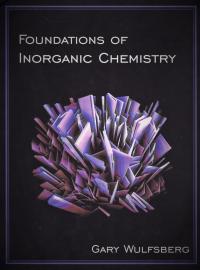Foundations of Inorganic Chemistry
Foundations of Inorganic Chemistry
By: Gary Wulfsberg
Foundations of Inorganic Chemistry by Gary Wulfsberg is our newest entry into the field of Inorganic Chemistry textbooks, designed uniquely for a one-semester stand alone course, or to be used in a full year inorganic sequence.
For all sales outside of the United States, please contact Felicity Henson, fhenson@aip.org
Title information
Foundations of Inorganic Chemistry by Gary Wulfsberg is our newest entry into the field of Inorganic Chemistry textbooks, designed uniquely for a one-semester stand alone course, or to be used in a full year inorganic sequence. By covering virtually every topic in the test from the 2016 ACS Exams Institute, this book will prepare your students for success. The new book combines careful pedagogy, clear writing, beautifully rendered two-color art, and solved examples, with a broad array of original, chapter-ending exercises. It assumes a background in General Chemistry, but reviews key concepts, and also assumes enrollment in a Foundations of Organic Chemistry course. Symmetry and molecular orbital theory are introduced after the student has developed an understanding of fundamental trends in chemical properties and reactions across the periodic table, which allows MO theory to be more broadly applied in subsequent chapters.
Use of this text is expected to increase student enrollment, and build students’ appreciation of the central role of inorganic chemistry in any allied field.
Key Features:
Over 900 end-of-chapter exercises, half answered in the back of the book.
Over 180 worked examples.
Optional experiments & demos.
Clearly cited connections to other areas in chemistry and chemical sciences.
Chapter-opening biographical vignettes of noted scientists in Inorganic Chemistry.
Optional General Chemistry review sections.
Originally rendered two-color illustrations throughout.
Chapter 1 Periodic Trends in Fundamental Properties of Atoms and Simple Ions
Chapter 2 Monatomic Ions and Their Acid–Base Reactivity
Chapter 3 Polyatomic Ions: Their Structures and Acid–Base Properties
Chapter 4 Ionic Compounds in the Solid State, in Minerals, and in Solution 1
Chapter 5 Trends in Coordination Equilibria
Chapter 6 Principles of Oxidation–Reduction Reactivity
Chapter 7 Introduction to Transition Metal Complexes
Chapter 8 Oxides and Silicates as Materials
Chapter 9 The Underlying Reasons for Periodic Trends
Chapter 10 Symmetry
Chapter 11 Molecular Orbital Theory: A Bridge Between Foundational and Advanced Inorganic Chemistry
Chapter 12 The Elements as Molecules and Materials
Appendix: Answers to Odd-Numbered Exercises
Photo and Figure Credits
Index
|
“There is a dire need for this one-semester text. I like the new Wulfsberg book. I think it is the right approach to the material.” “I am a devotee of this text. In particular, I like the way the book breaks down an incredible amount of information into discernable reactivity patterns and trends, particularly through use of the coordinated lab exercises/demonstrations that the students can use to apply to problems or unknown situations. This is much better than the typical element-by-element, encyclopedic approach used by other inorganic textbooks.” “This text is an excellent transition from General Chemistry to upper-level courses, and most students will find this book not only eminently readable but exciting. I was particularly impressed with the many in-chapter and end-of-chapter problems, their variety, and the very detailed answers given. With University Science Books’ very competitive pricing and the outstanding print quality, I will certainly adopt this text for my sophomore-level course.” |
Gary Wulfsberg
Gary Wulfsberg is Emeritus Professor of Chemistry at Middle Tennessee State University. He received his B.S. degree at Iowa State University and his Ph.D. degree in Inorganic Chemistry under Robert C. West at University of Wisconsin-Madison. His postdoctoral work was at the Cornell University Program on Science, Technology, and Society, and the Technical University of Darmstadt. Gary has served as chairman of the International Steering Committee for Nuclear Quadrupole Interactions, and he is the author of 40 publications and two previous University Science Books textbooks, Principles of Descriptive Inorganic Chemistry (1987, also translated into Italian) and Inorganic Chemistry (2000, also translated into French).

